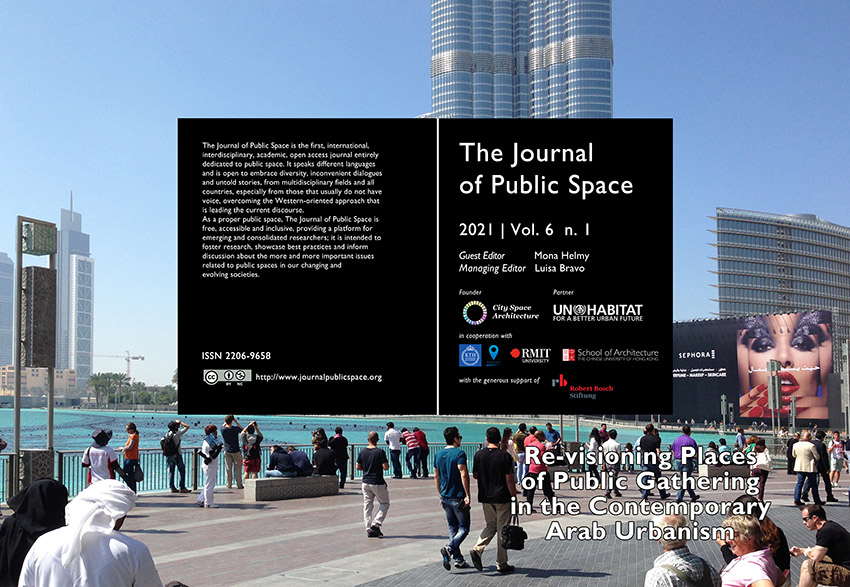What Happened to the Public Spaces of the Arab World? From Colonisation to Revolution: The Case of Lebanon
##plugins.themes.bootstrap3.article.main##
Abstract
Public spaces were first introduced into the Arab world through colonial authorities in a vision to “modernise” what was seen as “oriental cities”, since the 19th century until today. However, this process was brought under severe political, social, cultural, and economic circumstances. In the due date, the imported western models of public spaces were superimposed on the existing fabric, dismissing any of those components, which left public spaces to their tragic fate in the Arab cities. In that context, they were also snatched from their democratic and civic nature under the dictator regimes. The paper will be divided into five sections, starting with a look at the historical evolution of public spaces under colonisation, then it will take Beirut, Lebanon as a case study; a city that was torn by war and patched by western ideologies following the modernist movement. This will take a critical approach by looking at several players in the process of implementation of public spaces in Beirut. One of these being Solidere and its reconstruction plans of the city centre of Beirut after the civil war (1975-1990), which was heavily influenced by the western models of public spaces. In the third section, a comparative study between Piazza del Duomo in Italy and Martyrs’ Square in Lebanon will set a wider understanding of the product of this evolution. Eventually, the paper will analyse the impact of the Lebanese revolution (2019) on reclaiming the public spaces for the people, similar to other revolutions in the Arab world that date back to 2011, through examples like “The Egg”, Samir Kassir Garden and Martyr’s Square. By the hands of the revolutions, the people were able to domesticate what did not reflect their identity, culture or needs, and transform them into inclusive spaces for everyone from all races, classes and backgrounds as an opportunity to set a collective vision for the future. By that, a look and a recommendation for the future of the public spaces in the Arab world, especially Beirut, will take place through a concluding section.
##plugins.themes.bootstrap3.article.details##
The Authors retain copyright for articles published in The Journal of Public Space, with first publication rights granted to the journal.
Articles in this journal are published under the Creative Commons Attribution NonCommercial Licence (CC-BY-NC) - https://creativecommons.org/licenses/by-nc/4.0/.
You are free to:
• Share - copy and redistribute the material in any medium or format
• Adapt - remix, transform, and build upon the material
Under the following terms:
• Attribution - You must give appropriate credit, provide a link to the license, and indicate if changes were made. You may do so in any reasonable manner, but not in any way that suggests the licensor endorses you or your use.
• NonCommercial — You may not use the material for commercial purposes.
References
Asfar (2012). BEIRUT’S MAKE OVER. The meaning of “Solidere” 15 years later. [online] Available at: https://www.asfar.org.uk/beiruts-make-over-the-meaning-of-solidere-15-years-later/.
Al-Bishawi, M., Ghadban, S. and Jørgensen, K. (2017). Women’s behaviour in public spaces and the influence of privacy as a cultural value: The case of Nablus, Palestine. Urban Studies Journal, [online] Vol. 54(7), pp.1559–1577. Available at: http://journals.sagepub.com/home/usj [Accessed 21 Jun. 2019].
AKDN (n.d.). Samir Kassir Square | Aga Khan Development Network. [online] Available at: https://www.akdn.org/architecture/project/samir-kassir-square [Accessed 20 Jun. 2020].
Comero, D., Lo Verso, L., & Marino, P. (2016). Metropoli Milano, 3(322). Milan: Wayback Machine.
Faleh, M. (n.d.). How city squares can be public places of protest or centres of state control. [online] The Conversation. Available at: https://theconversation.com/how-city-squares-can-be-public-places-of-protest-or-centres-of-state-control-102275 [Accessed 24 Jun. 2020].
Fawaz, M. (2014). Planning Beirut During the French Mandate: The Construction of a Modern City and Its Legacy. [online] Jadaliyya. Available at: https://www.jadaliyya.com/Details/32202 [Accessed 27 June 2020].
Knoope, P. (2018). The Arab Spring and The Securitisation Of Space. [online] DOC Research Institute. Available at: https://doc-research.org/2018/01/arab-spring-securitisation-space/ [Accessed 24 June 2020].
Klaos, Y. (2018). Duomo Square, Milan: Cathedral of Milan, Royal Palace, Victor Emanuel II Gallery. [online] Available at: https://life-globe.com/en/duomo-square-milan/ [Accessed 20 Jul. 2020].
Lennard, S. (2004). Genius of The European Square | International Making Cities Livable. [online] Livablecities.org. Available at: https://www.livablecities.org/articles/genius-european-square [Accessed 20 June 2020].
Metrics, D. (2020). Capital Facts for Beirut, Lebanon [online]. Available at: https://www.worldscapitalcities.com/capital-facts-for-beirut-lebanon/ [Accessed 12 July 2020].
Niko N. (2016). Piazza del Duomo. https://nomadicniko.com/2016/12/21/piazza-del-duomo/
Rabbat N. (2012). The Arab Revolution Takes Back the Public Space. Critical Inquiry. 39, pp. 198-208.
Sanburn, J. (2011). Square Roots: How Public Spaces Helped Mold the Arab Spring. [online] TIME.com. Available at: http://content.time.com/time/world/article/0,8599,2071404,00.html [Accessed 30 June 2020].
Sinno, W. (2020) “How People Reclaimed Public Spaces in Beirut during the 2019 Lebanese Uprising”, The Journal of Public Space, 5(1), pp. 193-218. doi: https://doi.org/10.32891/jps.v5i1.1258.
The Economist. (2016). No bed of roses. [online] Available at: https://www.economist.com/middle-east-and-africa/2016/06/09/no-bed-of-roses [Accessed 15 July 2021].
Verdeil E. & Nasr J. (2008). The reconstructions of Beirut. Salma K. Jayyusi, Renata Holod, Attilio Petruccioli and André Raymond. The City in the Islamic World, Brill, pp.1116-1141, Handbook of Oriental Studies.
World Cities Culture Forum (2019). Percentage of public green space (parks and gardens). [online] Available at: http://www.worldcitiescultureforum.com/data/of-public-green-space-parks-and-gardens.

